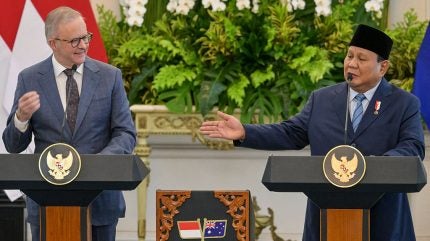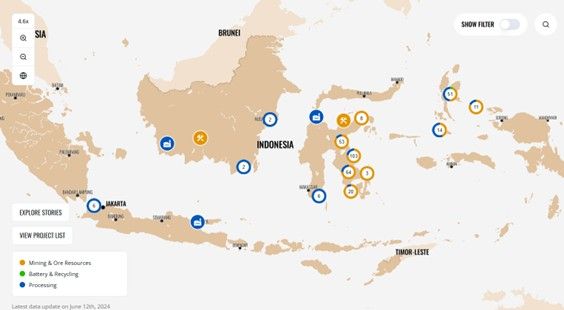
A mere day after swearing in his cabinet on 14 May, freshly re-elected Australian Prime Minister Anthony Albanese boarded a flight from Canberra to Jakarta, signifying to the world the importance his government places in the relationship with its northerly neighbours.
Waiting to greet Albanese for the first overseas visit of his second term was Indonesian President Prabowo Subianto. While there was undoubtedly much to discuss during their Indonesia-Australia Annual Leaders’ Meeting, Albanese and Subianto quickly turned to critical minerals, according to a joint communique, with frequent talk of “green infrastructure” and “clean energy projects”.

Discover B2B Marketing That Performs
Combine business intelligence and editorial excellence to reach engaged professionals across 36 leading media platforms.
The overarching trade-off underpinning the two nations’ arrangement is clear. Through the Australia-Indonesia Climate and Infrastructure Partnership, Jakarta secures supplies of lithium for its electric vehicle (EV) battery production amid a push to go green, while Canberra expands its market share for exports of its abundant critical minerals.
However, signs across the past six months have indicated that Australia’s interest transcends an increase in lithium exports.
Albanese’s broader vision is for Australia to rival China’s supply chain control as the world’s “critical mineral monolith” .
Beijing is a top producer of 30 of the 50 minerals labelled as “critical” by the US Geological Survey and oversees large swathes of international licensing, refining and processing. After US President Donald Trump initiated a trade war with China, Beijing restricted exports to the US of various minerals vital for smartphones, EV batteries and infrared missiles.

US Tariffs are shifting - will you react or anticipate?
Don’t let policy changes catch you off guard. Stay proactive with real-time data and expert analysis.
By GlobalDataSince the squeeze in supply to western nations, Australia has tried to position itself as a global producer of critical minerals, with some of the world’s largest deposits.
Challenges to investing in nickel
Paramount to Australia jostling for pole position as a critical minerals producer is nickel, which Indonesia has in abundance.
Home to two of the world’s five largest reserves of the metal, Sorowako and Weda Bay, the country is the world’s biggest producer of nickel, with 42.3% of global reserves. Australian mining companies have long eyed Indonesia’s nickel reserves, supported by the government’s desire to increase Canberra’s involvement in the global supply chain of the critical mineral used for EVs and stainless steel.
However, Chinese companies own approximately 40% of the production of mined nickel in Indonesia. They are also the shareholders of 75 of Indonesia’s 357 nickel mining, recycling and processing projects, according to China-Global South Project data.

Still, Indonesia has nickel to spare.
In 2022, it produced more than 1,400 tonnes (t) of nickel, according to industry insight from Mining Technology‘s parent company GlobalData. Two years later, President Subianto’s down-streaming and resource nationalism drove an increase to nearly 2,000t, continuing the global nickel surplus expected to last until 2027–28.
However, such high production also collapsed nickel prices, which averaged $16,234 per million tonnes during the third quarter of 2024, down a considerable 20.4% compared to the same period in 2023, reveals another GlobalData report.
In July this year, the Indonesian mining ministry announced plans to reduce the validity term for nickel mining quotas (otherwise known as RKABs), from three years to one, despite having initially extended the term from one to three to better control supply and support prices of nickel, coal and other commodities in 2023.
The decision was met with dismay by the Association of Indonesian Nickel Miners, which said the reduction would create unnecessary delays as thousands of miners would have to seek new quotas each year.
Analysts have pinpointed the price collapse, and subsequent unprofitability of the metal, as the primary reason for the closure or divestment of mines in Australia and New Caledonia, allowing Indonesia to grow its global share of production.
“Indonesia’s share of global mined nickel has surged from 16% in 2017 to over half of total production by 2024,” Gracelin Baskaran, director of the Critical Minerals Security Programme at the Center for Strategic and International Studies, tells Mining Technology. “This rapid growth has created a global nickel surplus, driven not only by Indonesia’s rising output but also by its ability to undercut competitors, pushing many Western producers out of business and consolidating its dominance in the global nickel market.
“The closure of nickel mines in Australia and other allied nations [of Indonesia] has left the world highly reliant on Indonesian nickel. Western producers cannot compete with low-cost Chinese production in Indonesia,” she adds.
To sidestep such unprofitability without full investment in Indonesia’s fluctuating nickel sector, some Australian companies have joint enterprise deals with Chinese counterparts.
Examples include the long-standing agreement between Australian company Nickel Industries (formerly Nickel Mines) and its partner Shanghai Decent Investment, which allowed Nickel Industries to purchase a 70% stake in the Angel Nickel project in Indonesia. Nickel Industries has also invested in the Hengjaya nickel iron project and has a partnership with Chinese operator Huayue Nickel Cobalt.
The environmental cost of the nickel rush
Indonesia has established a Ministry of Investment and Downstream Industry, promoting mineral down-streaming – or ‘hilirisasi’ – by banning exports on raw materials to encourage domestic processing. The hilirisasi policy aims to reduce reliance on coal through the downstream processing of mineral resources that are key to green industries, such as the manufacturing of EVs. However, some analysts question whether it leaves Indonesia caught between the need to go green and the financial benefits of coal and Chinese investment.
Despite Indonesia’s green mining ambitions, widespread reports of poor environmental, social and governance (ESG) records reveal that the hunt for nickel continues to damage key ecological sites.
In the Raja Ampat archipelago, a group of small islands in Indonesia’s Southwest Papua Province, known as the Amazon of the Seas for its marine biodiversity, nickel mining has stripped forests and polluted waters.
Photographs taken by Global Witness as part of an investigation appear to show the environmental damage already inflicted, with widespread forest loss and sediment run-off into waters that are home to biodiverse coral reefs.
In June, the Indonesian Government revoked permits for four out of five mining companies operating in the region, a decision closely monitored by the private sector and campaigners alike.
While President Subianto’s government has promised industrial growth and mass mineral production, it released a statement saying that: “Raja Ampat’s biodiversity is a world heritage that must be protected – we pay close attention to mining activities that occur in the area.”
Raja Ampat is far from unique. Nickel mining concessions on the island of Halmahera have resulted in at least 5,331 hectares of deforestation, leading to a loss of more than two tonnes of greenhouse gases stored in the forest. Mine waste and oil are also regularly dumped in fresh water, creating significant consequences for fishing and drinking water, undermining food security and creating health problems.
ESG standards in Indonesian nickel mining are largely considered voluntary. Reports by organisations including Baskaran’s suggest that the Indonesian Government would attract greater US or Australian investment through stronger compliance with “internationally recognised ESG certification frameworks”.
All considered, several barriers remain preventing Indonesia’s nickel market from flourishing – and Australian companies from investing in it. Overcoming the production surplus, down-streaming policy, fluctuating prices and ESG concerns will require prioritisation from government and the mining sector, although it seems diplomatic, political and commercial support for nickel is unwavering.



